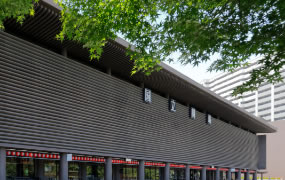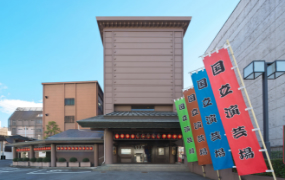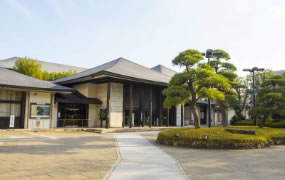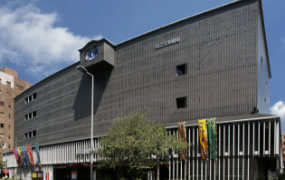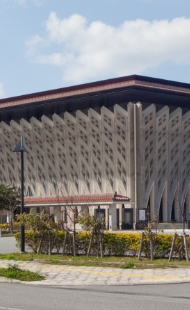New National Theatre, Tokyo (Playhouse)
Kabuki Performance in January 2024
"Kajiwara Heizō Homare no Ishikiri|Ashiya Dōman Ōuchi Kagami|Kioi jishi Kadode no Hatsudai"
Performance Dates : January 5 (Fri.) -27 (Sat.)
*No Performance on 11 (Thu.) and 22 (Mon.)
Venue :New National Theatre,Tokyo (Playhouse)
Performance Time
1:00PM - 4:50PM
*End times are estimates and could vary.
*There will be intermission.
Cast
Onoe Kikugorō
Onoe Kikunosuke
Bandō Hikosaburō
Nakamura Baishi
Nakamura Mantarō
Ichimura Takematsu
Ichimura Hikaru
Bandō Kamesaburō
Onoe Ushinosuke
Onoe Mahoro
Ogawa Hiroharu
Arashi Kitsusaburō
Kataoka Kamezō
Kawarasaki Gonjūrō
Ichimura Manjirō
Nakamura Tokizō
and others
Ticket Prices (including tax)
[1st Grade] Adults: 12,000 yen (Students: 8,400 yen)
[2nd Grade] Adults: 8,000 yen (Students: 5,600 yen)
[3rd Grade] Adults: 4,000 yen (Students: 2,800 yen)
⇒Special Offer for International Audiences (Welcome! Kabuki Ticket)
Seating Plan
*Audio guide: Japanese audio guides are available for rent. Click here for details of audio guide.
*Subtitles: Not available.
*English synopsis is available. It is included in the paid Japanese brochure.
Booking Opens
10 a.m.,December 13 (Wed.), 2023,
* If there are still tickets available for purchase on the day of the event, you may purchase them in person at the Box Office for this performance.
Box Office (on-site) : Open from 12:00 PM until curtain time.
*Tickets for students and persons with disabilities for this performance are available online.
-----------------------------------------------------------------------------
Box Office
0570-07-9900 (From overseas: +81-3-3230-3000) in Japanese and English (10:00AM-6:00PM)
http://ticket.ntj.jac.go.jp/top_e.htm
-----------------------------------------------------------------------------
in Japanese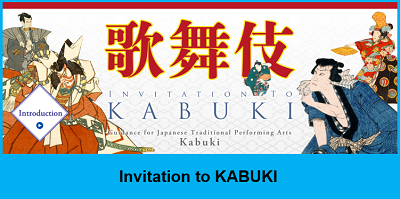

The Kabuki Performance in January 2024 – the very first presentation of Kabuki at the New National Theatre, Tokyo (Playhouse) – will feature two Kabuki pieces full of the appeals of Gidayū Kyōgen, and Tokiwazu-buyō, a style of dance that incorporates the rituals and customs of Edo. Please enjoy our first theater performance of the year in our series of New Year programs, presented by an impressive cast – you will see many familiar faces in the National Theatre’s New Year Kabuki Performance.
Kajiwara Heizō Homare no Ishikiri
This piece premiered as Ningyō Jōruri in 1730 under the title of “Miura no Ōsuke Kōbai Tazuna.” After being adapted into Kabuki the same year, part of the third act came to be staged as an independent program affectionately called “Ishikiri (stone-cutting) Kajiwara,” gaining popularity with its famous scene in which Kajiwara Heizō Kagetoki cuts the washbasin of the shrine right in half with an excellent sword.
Minamoto no Yoritomo, who had raised an army against the Heike clan, was defeated by Heike warriors including Ōba Saburō Kagechika. Kajiwara, who fought for the Heike clan, happens to be present at the place where the craftsman Rokurodayū and his daughter Kozue try to sell their family sword to Ōba. Asked to evaluate the sword, Kajiwara gives his seal of approval as to its quality.
To prove its worth to Ōba, he volunteers to perform a tameshigiri (test that trying a new sword out on a person), for which Rokurodayū offers to sacrifice himself. In the test, Kajiwara deliberately eases up on the power of his stroke so that Rokurodayū won’t die, disguising the sharpness of the sword. He then offers to buy it himself. Looking at the signature of the sword, Kajiwara learned that the father and daughter were from the Genji clan. He tells them that he once saved Minamoto no Yoritomo in the battlefield in recognition of his high caliber and conveys his determination to work for the Genji family as a sympathizer.
The highlights of this piece include the scene of judgement of the sword, the tricks in the test called futatsudō (to cut two bodies with one blow) that left Rokurodayū unharmed, Kajiwara’s confession of his true intention, the climactic “cutting of the stone” scene by Kajiwara and the passage highlighting the father and daughter’s care for each other. The great cast, including Kikunosuke in the role of Kajiwara for the first time, enlivens the performance.
Ashiya Dōman Ōuchi Kagami
This piece is known by the name of the protagonist, Kuzunoha. Among one of the old tales themed on human-animal marriage, in which animals or plants in human shape become a human’s wife, there is the legend that the mother of the onmyōji (master of Onmyōdō – the way of Yin and Yang) Abe no Seimei was actually a fox. The original piece premiered as Ningyō Jōruri in 1734 and adapted as Kabuki in the following year. The farewell scene between the mother, who has concealed her identity, and the little child became a popular act that has been independently staged.
In this tale, just after saving a white fox that has escaped from a fox hunting party, the onmyōji Abe no Yasuna is attacked by villains stalking his beloved Princess Kuzunoha and thus gets separated from her. When wounded Yasuna attempts suicide in despair, the princess appears suddenly, discouraging him from taking his own life. Escaping from the pursuers, they run away to Abeno in the Settsu Province. More than five years pass – the couple are living happily. Blessed with a baby boy, Kuzunoha is making a living by weaving. One day, however, another Princess Kuzunoha visits their place with her parents and then… Yasuna’s wife Kuzunoha is actually the white fox once saved by Yasuna. Before leaving, the fox comes out with the truth, saying that it had transformed into Princess Kuzunoha to save Yasuna’s life in return for his kindness, and became his wife in marrying him.
Directions such as the quick change of Kuzunoha’s costumes and “kusegaki,” the writing of the farewell tanka on the shōji (Japanese paper sliding door) through a unique technique, bring additional excitement to the play. With Nakamura Tokizō as Yasuna and Nakamura Baishi undertaking for the first time both roles of the fox Kuzunoha and the human Kuzunoha, the drama depicts vividly a moving parent-child affection.
Kioi Jishi Kadode no Hatsudai
Premiered in 1851 under the title of “Kioi Jishi Kabuki no Hanakago,” this piece was written by Segawa Jokō III, a Kabuki writer known for “Genjidana,” and the music composed by Kishizawa Shikisa IV. Originally, it was a dance to celebrate Soga Matsuri, which is associated with a theatrical play based on the story of the revenge of the Soga brothers. Against the backdrop of the customs of the Edo festival, various attractive characters such as a tobigashira (head fireman), geisha and tekomai (geisha dressed as a man) color the stage. The entire troupe, including Kikugorō and Tokizō, rounds off this New Year Kabuki Performance in a very lively and celebratory manner.


